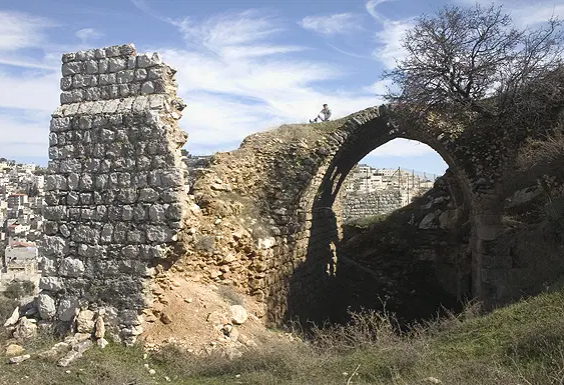Crusader House of Bones in the Field of Blood

The Valley of Hinnom (also called Gehenna or Gehinnom) is a valley that stretches to the west and south of the old city of Jerusalem. According to Jewish belief, this is the place where the worship of the Moloch cult took place at the end of the First Temple period. As part of the terrible pagan worship, the cult followers would sacrifice their children. The tradition attached to the valley was so horrific that it gave its name to the place where the wicked dwell after their death - Hell (Gehinnom in Hebrew).
על פי המסופר בברית החדשה, יהודה איש קריות, מי שבגד בישו והסגיר אותו לחיילים הרומאיים, קיבל 30 שקלי כסף בתמורה למעשיו. בכסף זה קנה שטח אדמה בגיא בן הינום, וזו הסיבה שהמקום מכונה "שדה הדמים", או "חקל דמא" בארמית. לפי גרסה אחרת, לאחר שהבין את טעותו החזיר יהודה את הכסף לידי הכוהנים, והם רכשו בעמק חלקת אדמה ששימשה לקבורה.
The entire area was part of the necropolis of Jerusalem during the Second Temple period, and to this day many burial caves can be found there. Beginning in the 4th century AD, the place was used as a public burial ground for Christian pilgrims who died during their visit to Jerusalem.
בתקופה הצלבנית הוקם במקום מבנה לקבורה המונית שסיפק פתרון קל וחסכוני לתמותה הרבה בקרב עולי הרגל שהגיעו לירושלים. המבנה היה מקורה בקמרונות ובגגו היו פתחים, דרכם הושלכו המתים פנימה. במקורות בני התקופה מכונה המבנה Carnier ובעברית "בית העצמות". חלקים מהמבנה שרדו עד ימינו וניתן למצוא אותם בסמוך למנזר סנט אונופריוס.
In the Middle Ages, a tradition started that the soil in the place is holy and that it has special qualities, allowing bodies to rot in just 3 days without bad smells. According to another tradition, those buried there were exempt from the threat of trial at the judgment day. Due to these beliefs, soil began to be taken from the site and sent to cemeteries throughout Europe.
The area continued to be used for burials during the following centuries as well. Its ownership changed over the years and it belonged, among others, to theKnights Hospitaller, the Armenians and the Greeks. The Turks called the place Sharnia, a mispronunciation of the word Carnier, and used it for executions as well. Burial in the place continued until a relatively late stage, and stopped only at the beginning of the 19th century.
(Anecdote authored by: עמיר)
(Number of views: 85)
